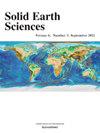Comprehensive geochemical and isotopic constraints on multi-stage magmatism and subsequent Cu– Mo (Au) mineralization in porphyry clusters of Kerman metallogenic belt, Iran: A perspective review
IF 2
4区 地球科学
Q3 GEOSCIENCES, MULTIDISCIPLINARY
引用次数: 0
Abstract
The Kerman Cenozoic Magmatic Assemblage (KCMA) is a key polymetallic producer within the Urumieh-Dokhtar Magmatic Belt (UDMB) in western Iran, hosting significant Cu– Mo (Au) porphyry type deposits and their epithermal Au and base metal equivalents. These deposits are formed at least into three primary clusters, i.e., Miduk, Sarcheshmeh, and Daralu, as well as sporadic individual occurences, which are closely associated with magmatic activity from the early Oligocene to the mid-late Miocene. This review synthesizes the geological and geochemical characteristics of ore-related intrusions in the Kerman region, integrating extensive published data to explore their sources and genesis. The U–Pb ages of Cu– Mo (Au) ore forming intrusions indicate two major magmatic phases, around ∼32 Ma and 20–10 Ma. The magmatism in the region produced numerous Cu– Mo (Au) mineralization-related intrusions, dominantly by diorite, monzodiorite, quartz diorite, and granodiorite composition. Geochemical evidence suggests that these intrusions originated from a shared source comprising varying proportions of slab-derived melts, metasomatized lithospheric mantle, and minor contributions from lower crustal materials. Notably, the felsic rock shows a greater incorporation of lower crustal materials compared to the more mafic rocks. The ore-related intrusions in the Kerman region were emplaced in a tectonic setting transitioning from subduction to collision and post-collision, reflecting both extensional and compressional regimes. Oxygen isotope data indicate that ore-forming fluids were primarily magmatic in origin, with minor contributions from meteoric water during the late stages of mineralization. Sulfur isotope analysis of sulfides reveals that the ore-forming materials were largely magmatic, with contributions from sedimentary components. This study provides a comprehensive overview of the magmatic and metallogenic evolution of the three principal ore clusters in the Kerman region.
伊朗Kerman成矿带斑岩群多期岩浆作用及后续铜钼(金)成矿作用的地球化学和同位素综合约束:远景回顾
Kerman新生代岩浆组合(KCMA)是伊朗西部乌鲁木齐-多克塔尔岩浆带(UDMB)内一个重要的多金属产地,具有重要的铜钼(Au)斑岩型矿床及其浅成热液型金和贱金属当量。这些矿床至少形成了Miduk、Sarcheshmeh和Daralu三个主要群,以及零星的个别出现,与早渐新世至中新世中晚期的岩浆活动密切相关。本文综合评述了Kerman地区与矿有关的岩体的地质和地球化学特征,结合大量已发表的资料,探讨了它们的来源和成因。Cu - Mo (Au)成矿侵入体的U-Pb年龄反映了2个主要岩浆阶段,约为~ 32 Ma和20 ~ 10 Ma。区内岩浆活动形成大量与铜钼(金)矿化有关的侵入体,主要由闪长岩、二黄长岩、石英闪长岩和花岗闪长岩组成。地球化学证据表明,这些侵入岩来自一个共同的来源,包括不同比例的板块衍生熔体、交代岩石圈地幔和少量来自下地壳物质的贡献。值得注意的是,与基性岩石相比,长英质岩石显示出更多的下地壳物质的结合。Kerman地区与矿有关的侵入体发育在从俯冲到碰撞和碰撞后过渡的构造环境中,反映了伸展和挤压两种作用机制。氧同位素资料表明,成矿流体主要为岩浆流体,成矿后期大气降水的贡献较小。硫化物硫同位素分析表明,成矿物质以岩浆为主,并有沉积成分的贡献。本文对克尔曼地区3个主要矿群的岩浆演化和成矿演化进行了全面概述。
本文章由计算机程序翻译,如有差异,请以英文原文为准。
求助全文
约1分钟内获得全文
求助全文
来源期刊

Solid Earth Sciences
GEOSCIENCES, MULTIDISCIPLINARY-
CiteScore
3.60
自引率
5.00%
发文量
20
审稿时长
103 days
 求助内容:
求助内容: 应助结果提醒方式:
应助结果提醒方式:


